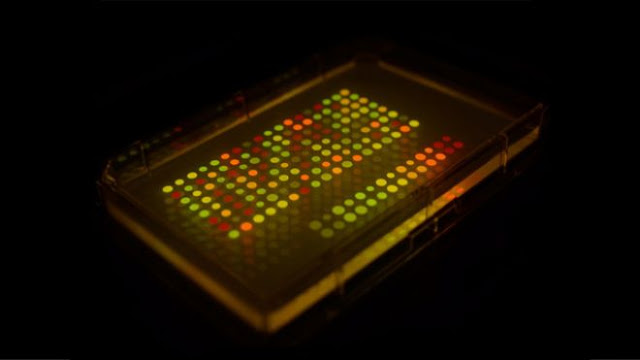Scientific espionage: microbial messaging.
Espionage just got a little more sophisticated and scientific. Invisible ink? Decoder rings? Lemon juice? Puh-lease -- that's mere child's play compared to what double agents scientists at Tufts University just created.
Now secret messages can be hidden in genetically engineered bacteria, thanks to a new method called steganography by printed arrays of microbes, or SPAM. Developed by chemistry professor David Walt and his cloak-and-dagger team of researchers, this new method uses an assortment of E. coli strains modified with fluorescent proteins that glow in seven colors.
Multiply that number by the two colors each message character is encoded with, and spies like us have more than 49 possible code combinations. That's enough for the alphabet, plus digits 0 to 9, with room left over for a few extra symbols.
The secret microbial messages are first grown in petri dishes. The cultures are then transferred to a thin film and ready to be sent to the desired undercover recipient. To unlock the message, the recipient must transfer the bacteria to a genetically modified growth medium, which acts as the secret key.
For example, the bacteria could be engineered to react only with a certain antibiotic, therefore allowing the message to be revealed only when in contact with that specific chemical. If any other chemical key is used, the message would be scrambled.
Self-destructing messages could also be created by using bacteria that loses its fluorescence over time.
Now secret messages can be hidden in genetically engineered bacteria, thanks to a new method called steganography by printed arrays of microbes, or SPAM. Developed by chemistry professor David Walt and his cloak-and-dagger team of researchers, this new method uses an assortment of E. coli strains modified with fluorescent proteins that glow in seven colors.
Multiply that number by the two colors each message character is encoded with, and spies like us have more than 49 possible code combinations. That's enough for the alphabet, plus digits 0 to 9, with room left over for a few extra symbols.
The secret microbial messages are first grown in petri dishes. The cultures are then transferred to a thin film and ready to be sent to the desired undercover recipient. To unlock the message, the recipient must transfer the bacteria to a genetically modified growth medium, which acts as the secret key.
For example, the bacteria could be engineered to react only with a certain antibiotic, therefore allowing the message to be revealed only when in contact with that specific chemical. If any other chemical key is used, the message would be scrambled.
Self-destructing messages could also be created by using bacteria that loses its fluorescence over time.


0 comments:
Post a Comment